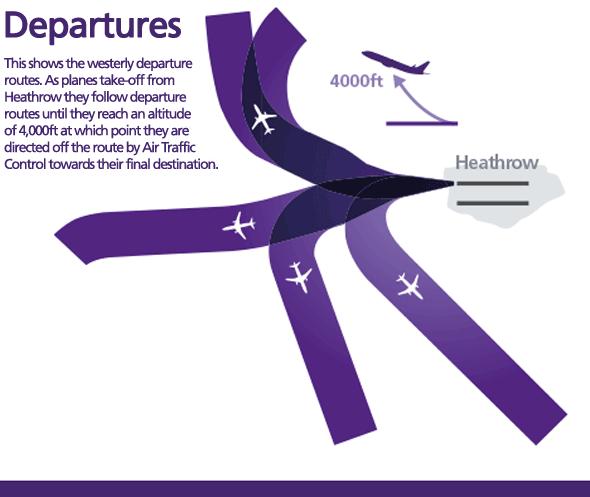Session is about to expire
Your session will timeout due to inactivity, please choose to continue your session if you’d would like to continue.
Heathrow is one of the busiest two-runway airports in the world with about 1,300 combined take-offs and landings a day. Efforts to limit noise mean that fewer people are affected by noise today than at any time since the 1970s. However, noise remains an issue for people living near or under the various flight paths used for take-offs and landings at the airport.
On average there are around 650 departures from Heathrow each day. The first departure is around 6:00am and the last scheduled departure is at 10:50pm.
Aircraft taking off from Heathrow follow pre-defined routes, known as Standard Instrument Departures routes (SIDs). The choice of SID used is decided by the airline and is predominately dictated by the destination of the aircraft. Due to the fact that all aircraft perform differently and may be affected by weather conditions which can cause them to drift left or right, there will be some variation as to where different aircraft will fly relative to the centreline of the SID. For this reason, when the SIDs were designed in the 1960s by the Department for Transport (DfT), the Government set corridors, known as Noise Preferential Routes (NPRs), which extend 1.5 kilometres either side of the SID route centreline.
Aircraft don’t have to follow the centreline of the SID precisely, they just have to be within the 3km wide NPR up to 4,000ft. Under government rules, once aircraft reach an altitude of 4,000ft, NATS air traffic controllers can direct planes off the departure route towards a more direct heading to their destination. This is known as vectoring.
Tracking keeping refers to how well aircraft stay within the NPR up to 4,000ft. Heathrow’s Noise and Track Keeping (NTK) system is used to detect any aircraft which deviate from a Noise Preferential Route (NPR).
Track keeping on Heathrow’s departure routes is very high overall, with over 95% of all departures staying within the published routes. The exception is the easterly Compton route – a departure route used during periods of easterly operations that heads west. Track keeping compliance is much lower on this route, and has been for many years.
We monitor how well planes stick to these routes, and publish data on track keeping on a daily basis on our Operational Data pages and annually in our Flight Performance reports.
Track deviations occur for a variety of reasons. They may be necessary for weather avoidance or strong winds, and the speed and weight of the aircraft are also significant factors. For example, faster aircraft have a wider radius of turn than older, slower aircraft.
The choice of which of the six departure routes aircraft take is a decision for airlines. It is dictated primarily by the destination of the flight but there are a number of other factors that influence this too, including international situations and the availability of the route. Heathrow has no power to dictate which route the airline takes.
The Department for Transport set rules regarding the height of aircraft on departure. The rules state that:
The climb rates will vary because aircraft climb at different rates depending on factors such as the type of aircraft, weather conditions or how fully laden they are. For example, bigger aircraft such as Airbus A380s will climb more slowly compared with smaller aircraft such as an A319 or A320, and therefore they may be lower than a smaller aircraft in the same position.
On occasions planes are directed to take a different route by Air Traffic Control or to leave the NPR below 4,000ft. This could be for a number of reasons such as thunderstorms, severe weather conditions or another aircraft such as a police helicopter that is flying within the departure route.
The majority of flights finish at Heathrow by 11:30pm, however sometimes late departures are unavoidable for a number of reasons. We are working with the airlines and NATS to reduce the number of flights that operate later than scheduled as we know they are disruptive to local residents.
A departing flight from Heathrow could be delayed because of bad weather (such as strong winds, fog or thunderstorms), a technical problem on board the aircraft or an emergency. If a flight needs to leave after 11:30pm for these reasons the airline must request permission and explain the reason for the delay.
Weather conditions such as severe thunderstorms or heavy snowfall can cause widespread disruption to our flight schedule and cause significant delays. In specific circumstances where prolonged and widespread delays occur on the airfield and terminals become congested to unacceptable levels, government guidance allows flights during the night period to be ‘dispensed’. These are in exceptional circumstances such as emergencies or situations where serious hardship or suffering to passengers would result.
